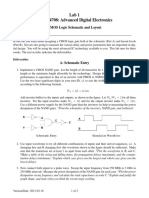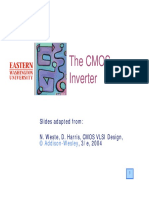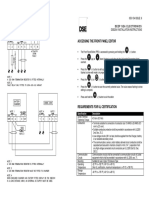Coen6511 Lecture 9: Digital Circuit Hierarchy
Coen6511 Lecture 9: Digital Circuit Hierarchy
Uploaded by
deathnote gotCopyright:
Available Formats
Coen6511 Lecture 9: Digital Circuit Hierarchy
Coen6511 Lecture 9: Digital Circuit Hierarchy
Uploaded by
deathnote gotOriginal Title
Copyright
Available Formats
Share this document
Did you find this document useful?
Is this content inappropriate?
Copyright:
Available Formats
Coen6511 Lecture 9: Digital Circuit Hierarchy
Coen6511 Lecture 9: Digital Circuit Hierarchy
Uploaded by
deathnote gotCopyright:
Available Formats
COEN6511 LECTURE 9
Digital Circuit Hierarchy
Static Circuit:
In General, digital circuits are divided into two classes:
Combinational: The outputs are function of the inputs only.
Sequential: The outputs are a function of the inputs as well as the states of the circuit.
Page 1 of 14 Lecture#9 Overview
CMOS Combinational Logic
Shown in figure below, is the general structure of this family of circuits. It has two major
parts, the path to VDD, through the pull up network and the path to Vss through the pull
down network. The pull up is a pmos network, while the pull-down is an nmos network.
Each gate will take 2N transistors, where N is the number of inputs.
Simple Example: an inverter
Page 2 of 14 Lecture#9 Overview
2-input NAND Gate
The NAND gate has two nmos transistors in series in the pull-down
and two pmos transistors in parallel in the pull-up network as shown
below.
The basic functionality of a 2-input NAND gate is given in the figure above Whenever
input A is ‘0’ and for any value of B, transistor A is active and will conduct, pulling the
output node high. Similarly, whenever input B is ‘0’ and irrespective of input A, transistor
B will drive the output node high. The only time that the output is low is when both A and
B are high, in which case the pull down network will become active at the same time,
pulling the output node low. This behavior is typical of ‘inverting logic’.
3-input NAND Gate
Increasing the pull-down and the pull-up series and parallel networks transistors by
one as shown in the diagram the 3-input NAND is constructed.
Page 3 of 14 Lecture#9 Overview
2-input NOR gate
2-input NAND Gate Sizing
Consider the following circuit
What will be the optimum size of the transistors which can optimize the circuit in terms
of power, delay and area?
The Aspect Ratio of an inverter is made to be Wp/Wn =µr (the mobility ratio) so that the
pull up and the pull down have the same drive strength, ie the same resistance.
Page 4 of 14 Lecture#9 Overview
The aim is to equalize rise and fall time, assuming that minimum width of an inverter is
Wp
Wnmin. for tr=tf , r let Lp=Ln=Lmin. That is, if r =3, then Wp = 3Wn. Then, the
Wn
sizing of Wn and Wp is shown in the figure above.
NOTE
This is an approaximate method. Approaximating PD and PU network by a single
transistor is wrong due to body effects of different regions of the circuit and internal
node capacitances.
Sizing of Transistors
Generally, assume Ln=Lp=Lmin unless otherwise stated,
For series pass transistors,
W W W
( ) effec [( 1 ) 1 ( 2 ) 1 ] 1 , that is we add the lengths together ie increase in
L L1 L2
resistance. Please note this is an approximation method.
For parallel pass transistors,
W W W
( ) effec ( 1 ) ( 2 ) , that is we add
L L1 L2
the widths together. ie increase in
conductance.
VTC and the impact of transistor
sizing
With one input being ‘0’ or ‘1’, only one
transistor is on while with two inputs being
Page 5 of 14 Lecture#9 Overview
“00”, two transistors become on, increasing the effective width to 2W min. Similarly, with
an input of “11”, the 2 NMOS transistors are on and this will divide the length by two
giving Weff=1/2.
Weff pull - up 2
4
Weff pull - down 1 / 2
To obtain the same VTC and noise margin as with an equivalent inverter, W n and Wp need
to be adjusted so as to give equal rise and fall time or Wp = r Wn effective.
2-input NOR Gate Sizing
Since the PMOS transistors are in series, the resistance adds up. As such, we need to
multiply the width in order to reduce resistance. That is, for Wn=Wn min in this circuit,
Wp=6Wmin, where 6 = 2x3, 2 for resistance and 3 for r .
NOTE
Design Technique
NOR gates are costly. For the same performance (computation efforts), it results in
increased area, power, delay, output load capacitance (due to an increase in drain
diffusion capacitance) and increase in input capacitance presenting higher load to driver
circuits. Convert your circuit to NAND whenever you can and avoid use of large fanin
NOR.
Page 6 of 14 Lecture#9 Overview
Complex Gates Design
Implement the following Boolean function:
F A B (D C)
The general idea is to start with the pull down structure, using series transistors for
“AND” and parallel transistors for OR as shown below. Transistor sizing is done for the
pull up path and pull down path to be equal to the design inverter. In the circuit below we
have sized the transistors for r of 2.
Page 7 of 14 Lecture#9 Overview
Transistors sizing is performed, now we look at the transistors ordering!
By replacing the branches, we may obtain a better performance for the same function. In
this circuit, put the smaller drain capacitances nearer to the output node.
Now we have a better circuit implementation as there are less drain
capacitances at the output node.
Please also note that even a better circuit can be obtained if we place the
transistors according to the signal arrival, with the ltest arriving signal
nearer to the output. This will be covered later.
Page 8 of 14 Lecture#9 Overview
Ratioed Logic (Pseudo NMOS)
The circuit uses N+1 transistors to implement a function, where n is the number of the
inputs. The pull-up is a single pmos with the rest of the pull down consists of nmos
transistors, thus saving in area greatly.
2-input NAND Pseudo NMOS
2-input NOR Pseudo NMOS
Page 9 of 14 Lecture#9 Overview
Complex Gates Design
F A B (D C)
The same design methodology applies here. Select
an optimum pseudo NMOS inverter and optimize
your gate accordingly.
Design technique
Remember that this is a ratioed logic, therefore the pull-down transistor/pull-up resistance
has to be calculated to give Vol<Vtn, where the value could be Vtn/2.
R pd V
*Vdd tn
R pd R pu 2
Advantages of using Pseudo NMOS are: Saving in area, faster depending on design.
Disadvantages: Static power dissipation, short circuit current, reduced noise margin.
Page 10 of 14 Lecture#9 Overview
Cascode Logic Family
Block diagram of a DCVS circuit (Differential Cascode Voltage Swing)
Page 11 of 14 Lecture#9 Overview
Example of Cascode Logic
A signal from one gate to the next is always transferred with its complement.
During switching a current spike takes place. This current is usually larger than that of a
complementary logic.
This logic is fully compatible with complementary logic because the output makes a full
swing between Vdd and Vss.
Both output and its complement are present.
The circuit uses mainly nmos transistors.
Slower than conventional complementary gate because during switching the pull-ups
have to “fight” the n pull-down trees.
Page 12 of 14 Lecture#9 Overview
A static Cascode (CVSL) complex logic gate
F ( A B) C ( D E )
The load for a static DCVS
Page 13 of 14 Lecture#9 Overview
The DCVS trees for a full adder Sum and Carry Pull-Down Networks
S’(A,B,C) = A’BC’ + A’B’C + ABC + AB’C’
S (A,B,C) = A’B’C’ + A’BC + ABC’ + AB’C
C(A,B,C) = AB + BC + AC
END OF LECTURE #9
Page 14 of 14 Lecture#9 Overview
You might also like
- Sub Sea Cable Laying. r1Document138 pagesSub Sea Cable Laying. r1contact_amit_01No ratings yet
- Automated Broad and Narrow Band Impedance Matching for RF and Microwave CircuitsFrom EverandAutomated Broad and Narrow Band Impedance Matching for RF and Microwave CircuitsNo ratings yet
- Static Cmos DesignDocument7 pagesStatic Cmos Designtechspaceofatul100% (3)
- Earth and Straw Constructions in CreteDocument90 pagesEarth and Straw Constructions in CreteCosmic BoatripNo ratings yet
- Pass Gate Logic: Switch NetworkDocument34 pagesPass Gate Logic: Switch NetworkSunil SharmaNo ratings yet
- Ratioed Logic: R Resistive Load V 0 Depletion Load V 0 Pmos LoadDocument13 pagesRatioed Logic: R Resistive Load V 0 Depletion Load V 0 Pmos LoadAmjad WadalaNo ratings yet
- Answer Key - Vlsi CIA IDocument5 pagesAnswer Key - Vlsi CIA IMaadheshNo ratings yet
- VLSI Design SoC CH 6Document125 pagesVLSI Design SoC CH 6Arqam Ali KhanNo ratings yet
- Vlsi DesignDocument31 pagesVlsi Designajas777BNo ratings yet
- Euler's PathDocument10 pagesEuler's PathSatish Kumar0% (1)
- CMOS Interview QADocument14 pagesCMOS Interview QAarammartNo ratings yet
- Wang1991 Article Current-modeCMOSIntegratedCircDocument9 pagesWang1991 Article Current-modeCMOSIntegratedCircchanducherry846No ratings yet
- DAC AnalysisDocument19 pagesDAC Analysisమురళీధర్ ఆది ఆంధ్రుడుNo ratings yet
- Combination Logic Design: Pradondet Nilagupta Pom@ku - Ac.th Department of Computer Engineering Kasetsart UniversityDocument78 pagesCombination Logic Design: Pradondet Nilagupta Pom@ku - Ac.th Department of Computer Engineering Kasetsart UniversitybhawnaNo ratings yet
- Lab 1 ELEC-4708: Advanced Digital Electronics: CMOS Logic Schematic and LayoutDocument2 pagesLab 1 ELEC-4708: Advanced Digital Electronics: CMOS Logic Schematic and LayoutSiam HasanNo ratings yet
- Revisit: Resistance and Capacitance MOSFET Model For Digital CircuitsDocument33 pagesRevisit: Resistance and Capacitance MOSFET Model For Digital Circuitsdilshan singhNo ratings yet
- The Cmos Inverter: OutlineDocument20 pagesThe Cmos Inverter: OutlinehappyharrNo ratings yet
- Combinational Mos Logic Circuits: Basic ConceptsDocument41 pagesCombinational Mos Logic Circuits: Basic Conceptsflampard24No ratings yet
- Chap16 1 NMOS InverterDocument50 pagesChap16 1 NMOS Invertervlsijp100% (1)
- 8 Delay Estimation 09-09-2024Document90 pages8 Delay Estimation 09-09-2024leenakannan.237No ratings yet
- Analysis and Design of Analog IcDocument21 pagesAnalysis and Design of Analog Icshankar100% (1)
- Snubber Circuit Design CalculatorsDocument3 pagesSnubber Circuit Design CalculatorsteomondoNo ratings yet
- 5 2 10 While The Width of Nmos Transistor Is 6 . The Length of The Channel For Both Pmos and Nmos TransistorDocument14 pages5 2 10 While The Width of Nmos Transistor Is 6 . The Length of The Channel For Both Pmos and Nmos TransistorChiranth M PatilNo ratings yet
- Vsli Unit 2 Question Bank With AnswersDocument10 pagesVsli Unit 2 Question Bank With AnswersPavani NNo ratings yet
- EC6601 VLSI Design Model QBDocument44 pagesEC6601 VLSI Design Model QBxperiaashNo ratings yet
- SOC Unit 1 Part2Document24 pagesSOC Unit 1 Part2Karthick NpNo ratings yet
- VLSI Design Lecture NotesDocument117 pagesVLSI Design Lecture NotesRaji SharmiNo ratings yet
- Combination Logic CircuitsDocument21 pagesCombination Logic Circuitsamitssaksena100% (1)
- Physical DesignDocument45 pagesPhysical DesignMalka RavikrishnaNo ratings yet
- The Inverter: Presented By: Erica Niña Ignacio Phildrick Perea Janvoi de TazaDocument19 pagesThe Inverter: Presented By: Erica Niña Ignacio Phildrick Perea Janvoi de TazaSydney BajentingNo ratings yet
- Physical DesignDocument45 pagesPhysical DesignSameer Badachi100% (10)
- Lab (GPDK)Document49 pagesLab (GPDK)Murali MurariNo ratings yet
- Buffer Stage For Fast Response Ldo 152Document4 pagesBuffer Stage For Fast Response Ldo 152Praveen BeniwalNo ratings yet
- The Cmos Inverter: Slides Adapted From: N. Weste, D. Harris, CMOS VLSI Design,, 3/e, 2004Document40 pagesThe Cmos Inverter: Slides Adapted From: N. Weste, D. Harris, CMOS VLSI Design,, 3/e, 2004Vidhya DsNo ratings yet
- The Cmos Inverter: Slides Adapted From: N. Weste, D. Harris, CMOS VLSI Design,, 3/e, 2004Document40 pagesThe Cmos Inverter: Slides Adapted From: N. Weste, D. Harris, CMOS VLSI Design,, 3/e, 2004Vidhya DsNo ratings yet
- Unit-Ii Cmos CircuitsDocument34 pagesUnit-Ii Cmos CircuitsgnitsiceNo ratings yet
- Low Power MuxDocument4 pagesLow Power MuxPromit MandalNo ratings yet
- Vlsi 2-Marks With AnswerDocument23 pagesVlsi 2-Marks With Answerk poornimaNo ratings yet
- Vlsi Unit 4Document100 pagesVlsi Unit 4SRHNo ratings yet
- Chapter 6 BDocument22 pagesChapter 6 BSuraj KumarNo ratings yet
- VLSI Design NotesDocument130 pagesVLSI Design NotesThilakavathi100% (1)
- Low-Voltage CMOS Analog Bootstrapped Switch For Sample-and-Hold Circuit: Design and Chip CharacterizationDocument4 pagesLow-Voltage CMOS Analog Bootstrapped Switch For Sample-and-Hold Circuit: Design and Chip CharacterizationwhamcNo ratings yet
- Lecture - MOS & MOSFET-1Document21 pagesLecture - MOS & MOSFET-1Kartika MunirNo ratings yet
- Low Power CMOS Digital Circuit Design Methodologies With Reduced Voltage SwingDocument4 pagesLow Power CMOS Digital Circuit Design Methodologies With Reduced Voltage SwingMaheshNo ratings yet
- Iscas06 Curr RefDocument4 pagesIscas06 Curr Refkareka_ccNo ratings yet
- Reference Guide To Useful Electronic Circuits And Circuit Design Techniques - Part 2From EverandReference Guide To Useful Electronic Circuits And Circuit Design Techniques - Part 2No ratings yet
- Reference Guide To Useful Electronic Circuits And Circuit Design Techniques - Part 1From EverandReference Guide To Useful Electronic Circuits And Circuit Design Techniques - Part 1Rating: 2.5 out of 5 stars2.5/5 (3)
- High-Performance D/A-Converters: Application to Digital TransceiversFrom EverandHigh-Performance D/A-Converters: Application to Digital TransceiversNo ratings yet
- STEM: Science, Technology, Engineering and Maths Principles Teachers Pack V10From EverandSTEM: Science, Technology, Engineering and Maths Principles Teachers Pack V10No ratings yet
- Highly Integrated Gate Drivers for Si and GaN Power TransistorsFrom EverandHighly Integrated Gate Drivers for Si and GaN Power TransistorsNo ratings yet
- Analog Dialogue, Volume 48, Number 1: Analog Dialogue, #13From EverandAnalog Dialogue, Volume 48, Number 1: Analog Dialogue, #13Rating: 4 out of 5 stars4/5 (1)
- Easy(er) Electrical Principles for General Class Ham License (2019-2023)From EverandEasy(er) Electrical Principles for General Class Ham License (2019-2023)No ratings yet
- Easy(er) Electrical Principles for Extra Class Ham License (2012-2016)From EverandEasy(er) Electrical Principles for Extra Class Ham License (2012-2016)No ratings yet
- Easy(er) Electrical Principles for General Class Ham License (2015-2019)From EverandEasy(er) Electrical Principles for General Class Ham License (2015-2019)Rating: 5 out of 5 stars5/5 (1)
- Model D ManualDocument38 pagesModel D ManualVahidNo ratings yet
- Fluid Power Control - Web Course PDFDocument2 pagesFluid Power Control - Web Course PDFvitor_pedro100% (1)
- New Development With Supermarché - China Suzhou Sigmetal 2Document24 pagesNew Development With Supermarché - China Suzhou Sigmetal 2Koné Ibrahim KhalilNo ratings yet
- Game of Thrones Fan 3D Prints His Very Own Replica of Oberyn Martell's Blade PDFDocument5 pagesGame of Thrones Fan 3D Prints His Very Own Replica of Oberyn Martell's Blade PDFBruna CastanheiraNo ratings yet
- ToolboxLog JDJDocument6 pagesToolboxLog JDJHarshit AgarwalNo ratings yet
- DT821-SC - Ficha TécnicaDocument4 pagesDT821-SC - Ficha TécnicaAlexandra chata monsalve momsalveNo ratings yet
- Brush Size and MeasuringDocument2 pagesBrush Size and MeasuringKarol D ArizaNo ratings yet
- MCB MCCBDocument7 pagesMCB MCCBDuy PhamNo ratings yet
- Pickhammers: IR2 - IR12Document4 pagesPickhammers: IR2 - IR12Jamal HabbasNo ratings yet
- DeepCrawl Ultimate Guide To JavaScript For SEODocument70 pagesDeepCrawl Ultimate Guide To JavaScript For SEOvitorwelNo ratings yet
- Jimny Service IntervalsDocument3 pagesJimny Service IntervalsCW RRNo ratings yet
- Lexmark 7300 Series (4418.sm)Document88 pagesLexmark 7300 Series (4418.sm)JOSE LUIS PINO MANUELNo ratings yet
- Research Design: Unit-IIIDocument34 pagesResearch Design: Unit-IIIAshok Kumar UppariNo ratings yet
- Pokémon Clover Main Doc (New Edition) (Recovered)Document367 pagesPokémon Clover Main Doc (New Edition) (Recovered)maverickbastardNo ratings yet
- Centaflex-A: Assembly and Operating Instructions 008A-00001 00600-GN, - GZ, - GB.. M008-00064-EN Rev. 7Document88 pagesCentaflex-A: Assembly and Operating Instructions 008A-00001 00600-GN, - GZ, - GB.. M008-00064-EN Rev. 7Zvonimir MorožinNo ratings yet
- Compressed Air Part2Document14 pagesCompressed Air Part2HmidaNo ratings yet
- How To Install Ubuntu LinuxDocument10 pagesHow To Install Ubuntu LinuxTrisna Agung MahendraNo ratings yet
- Typical Wiring Diagram: Deep Sea ElectronicsDocument2 pagesTypical Wiring Diagram: Deep Sea ElectronicsBERANGER DAVESNE DJOMALIA SIEWENo ratings yet
- Enerpac RRH-Series, Hollow Plunger CylindersDocument2 pagesEnerpac RRH-Series, Hollow Plunger CylinderstdzeienNo ratings yet
- 14nm - 16nm Processes PDFDocument1 page14nm - 16nm Processes PDFGagandeep Singh DhingraNo ratings yet
- 401 189Document1 page401 189Putri AmeraNo ratings yet
- Recommendation LetterDocument2 pagesRecommendation Letterirshad hussain100% (1)
- 2-78 Peak SIM LockDocument49 pages2-78 Peak SIM LockTiwakorn DarajitNo ratings yet
- CNC Technology MCQDocument36 pagesCNC Technology MCQAkash100% (1)
- viewNitPdf 4392019Document18 pagesviewNitPdf 4392019f1479462No ratings yet
- JOB Description: BMS Operator FM Operations Electrical Engineer Electrical Supervisor Main Purpose of JobDocument2 pagesJOB Description: BMS Operator FM Operations Electrical Engineer Electrical Supervisor Main Purpose of Jobshahbazalam4a5No ratings yet
- Esr-1185 022021Document7 pagesEsr-1185 022021Mikel Lasa MuñagorriNo ratings yet
- Specification: Constant Current Discharge Characteristics: A (25)Document2 pagesSpecification: Constant Current Discharge Characteristics: A (25)GeorgeNo ratings yet

























































































